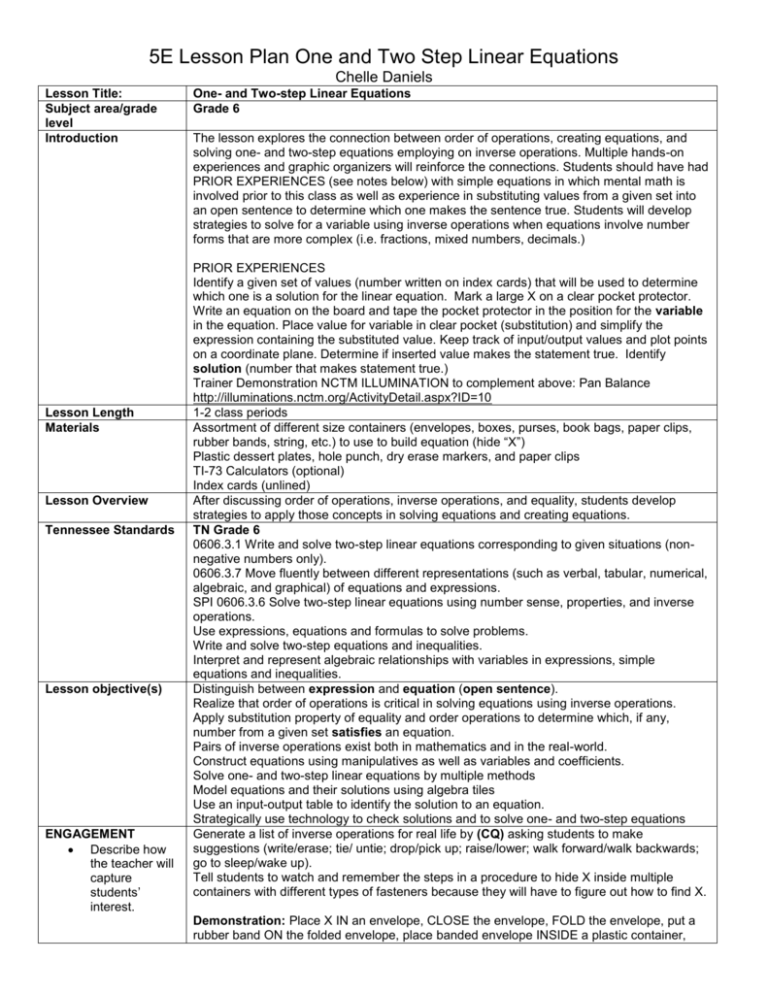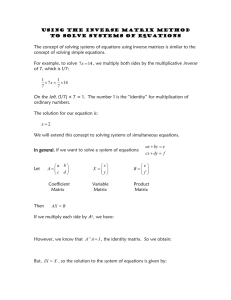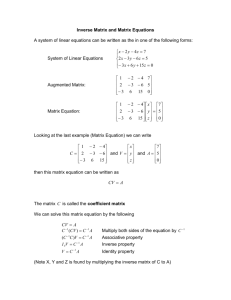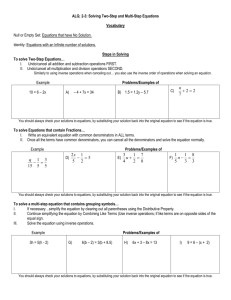5E LESSON One and Two Step Linear Equations Chelle Daniels
advertisement

5E Lesson Plan One and Two Step Linear Equations Chelle Daniels Lesson Title: Subject area/grade level Introduction Lesson Length Materials Lesson Overview Tennessee Standards Lesson objective(s) ENGAGEMENT Describe how the teacher will capture students’ interest. One- and Two-step Linear Equations Grade 6 The lesson explores the connection between order of operations, creating equations, and solving one- and two-step equations employing on inverse operations. Multiple hands-on experiences and graphic organizers will reinforce the connections. Students should have had PRIOR EXPERIENCES (see notes below) with simple equations in which mental math is involved prior to this class as well as experience in substituting values from a given set into an open sentence to determine which one makes the sentence true. Students will develop strategies to solve for a variable using inverse operations when equations involve number forms that are more complex (i.e. fractions, mixed numbers, decimals.) PRIOR EXPERIENCES Identify a given set of values (number written on index cards) that will be used to determine which one is a solution for the linear equation. Mark a large X on a clear pocket protector. Write an equation on the board and tape the pocket protector in the position for the variable in the equation. Place value for variable in clear pocket (substitution) and simplify the expression containing the substituted value. Keep track of input/output values and plot points on a coordinate plane. Determine if inserted value makes the statement true. Identify solution (number that makes statement true.) Trainer Demonstration NCTM ILLUMINATION to complement above: Pan Balance http://illuminations.nctm.org/ActivityDetail.aspx?ID=10 1-2 class periods Assortment of different size containers (envelopes, boxes, purses, book bags, paper clips, rubber bands, string, etc.) to use to build equation (hide “X”) Plastic dessert plates, hole punch, dry erase markers, and paper clips TI-73 Calculators (optional) Index cards (unlined) After discussing order of operations, inverse operations, and equality, students develop strategies to apply those concepts in solving equations and creating equations. TN Grade 6 0606.3.1 Write and solve two-step linear equations corresponding to given situations (nonnegative numbers only). 0606.3.7 Move fluently between different representations (such as verbal, tabular, numerical, algebraic, and graphical) of equations and expressions. SPI 0606.3.6 Solve two-step linear equations using number sense, properties, and inverse operations. Use expressions, equations and formulas to solve problems. Write and solve two-step equations and inequalities. Interpret and represent algebraic relationships with variables in expressions, simple equations and inequalities. Distinguish between expression and equation (open sentence). Realize that order of operations is critical in solving equations using inverse operations. Apply substitution property of equality and order operations to determine which, if any, number from a given set satisfies an equation. Pairs of inverse operations exist both in mathematics and in the real-world. Construct equations using manipulatives as well as variables and coefficients. Solve one- and two-step linear equations by multiple methods Model equations and their solutions using algebra tiles Use an input-output table to identify the solution to an equation. Strategically use technology to check solutions and to solve one- and two-step equations Generate a list of inverse operations for real life by (CQ) asking students to make suggestions (write/erase; tie/ untie; drop/pick up; raise/lower; walk forward/walk backwards; go to sleep/wake up). Tell students to watch and remember the steps in a procedure to hide X inside multiple containers with different types of fasteners because they will have to figure out how to find X. Demonstration: Place X IN an envelope, CLOSE the envelope, FOLD the envelope, put a rubber band ON the folded envelope, place banded envelope INSIDE a plastic container, 5E Lesson Plan One and Two Step Linear Equations Chelle Daniels and put the top ON the container. Ask students to list from memory the demonstrated actions. (CQ) Ask students to identify, in order, the procedures that will “undo” the steps in order to “find X.” Prompt them to look at both lists (either side by side or one above the other and make observations. (HOT) Work with their observations to generalize from ‘order of operations on X’ to operations that must be performed to find X.’ (HOT) Guide them in developing a graphic organizer to relate the first list and the second list of actions (operations) they will determine that finding X requires using inverse operation in reverse order. (See handout for graphic organizers – X in the BOX, RAINBOW) What kind of questions should the students ask themselves after the engagement? EXPLORATION Describe what handson/minds-on activities students will be doing. Hands-On Activity: Use manipulatives to create situation in which they hide X (as demonstrated). Small groups choose supplies/equipment, hide X, and list the operations performed “DO”. Trade container and list with another group. The group creates and records the requires list of inverse operations in the correct order to “UNDO” the performed operations to “solve for X” and finds X. Student questions: What do inverse operations have to do with math? What inverse operations exist in mathematics besides +/- and x/ ? How does this procedure work with numbers? When do we ever need to find something hidden in math? (CQ) How can we use what we have just seen to help us in mathematics? To what kind of math problems can we apply the process we discovered? In mathematics, we often need to find a value for a variable that will make an equation (open sentence) a true statement. What value for m will make this statement true? 6.2m 35.34 What value for n will make this statement true? 3 n 18 52 4 Ask (CQ) how important was order of operations as noted in hiding and finding X? Utilize graphic organizer DO-UNDO developed with hands-on activity to solve several equations. (See directions and example on teacher notes handout.) Emphasize that the roles of order of operations and inverse operations in solving an equation are important. List “big idea” conceptual questions the teacher will use to encourage and/or focus students’ exploration EXPLANATION Student explanations (OE) Reinforcing activity for two-step equations: Punch holes on the top edge and bottom edge of plastic dessert plates. With a dry erase marker, label the front of each plate with one individual operation done to x. Flip each plate over (top to bottom) and label the back side with the inverse operation for the operation that is on the front. From top to bottom, sequence operations done to variable and connect with paper clips, string, or twist ties. When all plates are turned over, you will be able to see the reversed order for inverse operations for solving two-step (or more) equations. Big Ideas: Solving an equation is a process in which a value is found for a variable that will make an open sentence true. Order of operations, and inverse operations are tools to use when solving an equation. Discuss Inverse Operations: (CQ) What are the inverse operations in mathematics? (CQ) What is the effect on a number if both of the inverse operations are performed? The objective is understanding of the relationship of the effects of inverse operations - that 5E Lesson Plan One and Two Step Linear Equations Chelle Daniels should precede introduction of terms or explanations by the teacher. What questions or techniques will the teacher use to help students connect their exploration to the concept under examination? List higher order thinking (HOT) questions which teachers will use to solicit student explanations and help them to justify their explanations. what the first operation did “do” to the number, the inverse operation will “undo”. (CQ) Ask students for a pair of inverse operations and use their suggestions so demonstrate concept similar to examples below. Start 5 5 2 7 Inverseoperations : "add 2"and"subtract 2" 7 2 5 End 5 Start 12 12 3 4 Inverse operations : "divideby 3"and "multiplyby 3" 4 3 12 End 12 Discuss concept of equality integral to both creating an equation and solving an equation. Stress the meaning of “=”; note that operation is performed on both of the two equal numbers so that the numbers remain equal. Illustrate real-life situation with diagram: Both you and your friend have the same plate. = You and your friend both add a sandwich. = You and your friend both add an apple. = What if only your friend gets an ice cream cone? Not = Transfer understanding to numerical equality. Emphasize the “equality” of the two numbers as long as both numbers undergo the same operations. (Properties are given for teacher knowledge and it is not necessary for students to know names but it is necessary for them to understand the concept.) 10 10 10 5 10 5 Addition property of equality 15 15 4(15) 4(15) Multiplication property of equality 60 60 60 60 3 3 20 20 Division property of equality 20 7 20 7 Subtraction property of equality 13 13 Solve several one-step/two-step equations with student input. Create do/undo lists as shown on the handout with the graphics. Identify inverse operations. Emphasize that the operation is being done to both expressions so that they are being kept equal (formally properties of equality.) (OE) YOUR TURN! Individual practice. Provide 2-3 equations. Tell students that the important part of this exercise is to identify the “DO LIST” (order of operations on the variable) and to use that to develop the “UNDO LIST” (reverse order of inverse operations). 5E Lesson Plan One and Two Step Linear Equations Chelle Daniels Make sure they understand that being able to show and communicate their thinking in this manner is one of the main objectives in mathematics. Circulate while students are creating the lists and solving the equations making sure students are performing the same operation to both members of the equation. ELABORATION Describe how students will develop a more sophisticated understanding of the concept. Students develop understanding when they create their own equations. The first activity reinforces that the solution to an equation makes the open sentence a true statement. The second one applies properties of equality to work from a solution to develop an equation for the solution. (OE) Paired Equation Construction: Each student receives an index card (with different onestep or two-step expressions on one side). Each student draws a number card (from set of appropriate types of numbers: whole numbers, decimal numbers, fractions, or mixed numbers), substitutes number into the expression, evaluates the expression, and places value into other side of equation. Students trade cards with partner, solve partner’s equation on paper, checks solution with partner. Let each pair of partners trade equations with another pair of partners and solve the new equations, etc. For every solution there is a problem. Students will create their own equations to be solved by their peers. Demonstrate: one-step equation Begin with a solution in the form variable equals value; perform same operation on both sides of the equal sign, p 50 22 MY EQUATION! p 50 72 50 Subtraction property of equality p 72 h 6 11 6 Multiplication property of equality 11 11h 6 MY EQUATION ! 11h 11 Demonstrate: two-step equation 2 7 2 30 k4 7 7 30 7k 7 Step1 : Multiplication propperty of equality 7 30 7k 5 7 5 Step 2 : Addition property of equality 7 30 5 35 Evaluate useorder of operations 7k 5 35 MY EQUATION !!! k4 5E Lesson Plan One and Two Step Linear Equations D 42 What vocabulary will be introduced and how will it connect to students’ observations? How is this knowledge applied in our daily lives? Chelle Daniels D 42 Step1 : Division property of equality 2 2 D 42 7 7 Step 2 :Subtraction property of equality 2 2 21 7 14 Evaluate :useorder of operations D 7 14 2 MY EQUATION ! (OE) Give each student a solution card on which they will construct an equation for the solution. Let them show their work on the board Or post their equations on a bulletin board. Students will verbalize understanding of terms as they arise in the lesson: expression, equation, solve, solution. (OE) Journal Prompt: Comparing inverse operation in real world to solving equations. (SNOW DAY) EXTENSION INVOLVING TECHNOLOGY (optional) EVALUATION How will students demonstrate that they have achieved the lesson objective? This should be embedded throughout the lesson as well as at the end of the lesson Check solutions on the TI-73 calculator. Use substitution on the TI-73 calculator to evaluate expression member of equation. True/false: Use the true/false logic output on the TI-73 calculator in which 0 = false and 1 = true to check equivalences. Connect to computer programming. Use input/output chart or the Table on the TI-73 calculator: Input variable side of equation in Y1 and constant side of expression in Y2. Locate value for X that makes both columns Y1 and Y2 equal. Consider limitations of this method: Is the table set up to use fractional values for x? STEM Discussion: Evaluate strategic use of technology. Are the main objectives of this lesson to develop computational skills or develop conceptual understanding? Does the activity with technology enhance conceptual understanding of mathematics? Is the computation at a level of complexity that doing it manually will overshadow the learning objectives? (OE) Opportunities for evaluation Determine if a number is a solution to an equation: place 0-9 in correct equation (group activity) Perplexing polygons (handout) Abc’s and 123’s (Advanced handout)








